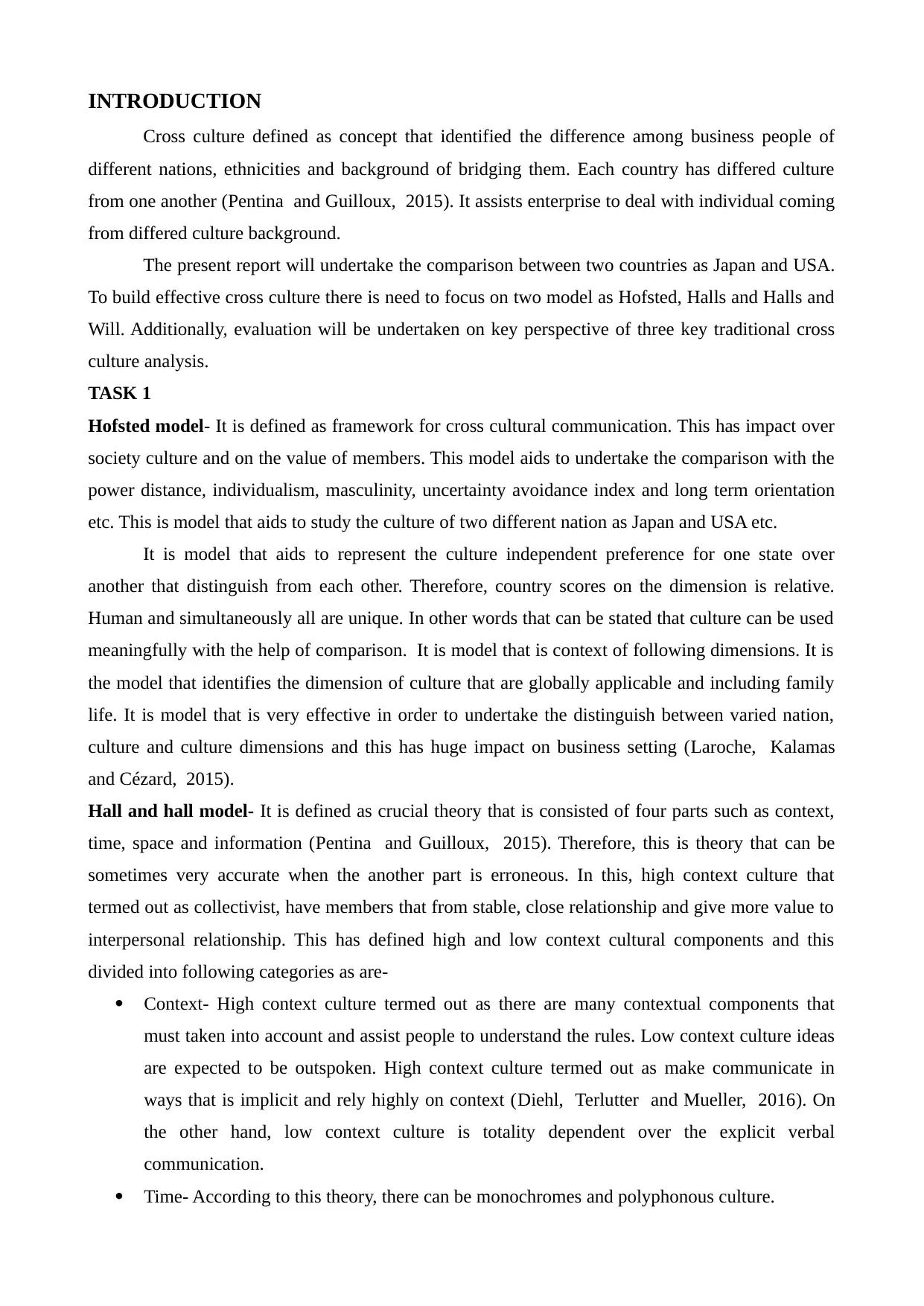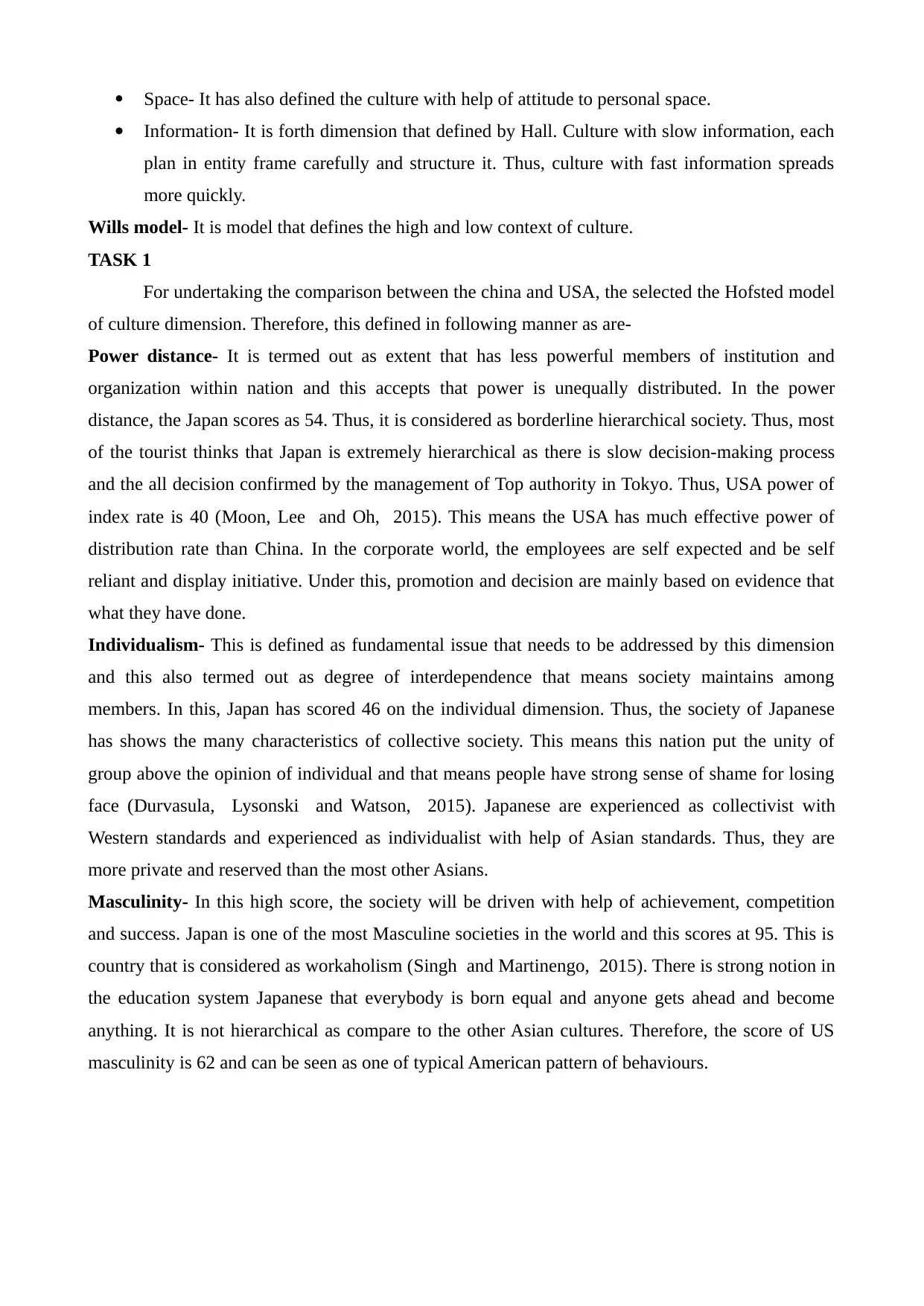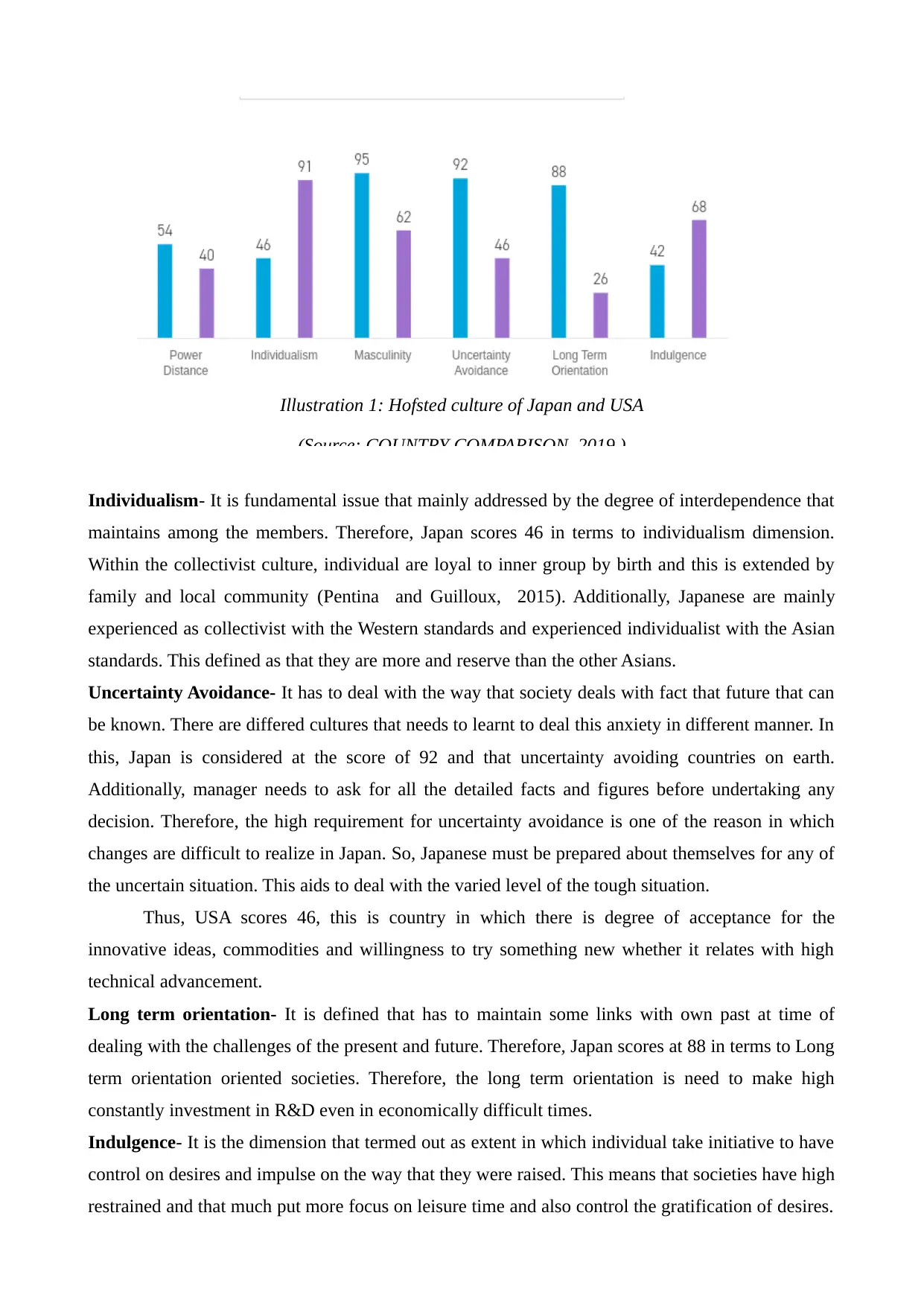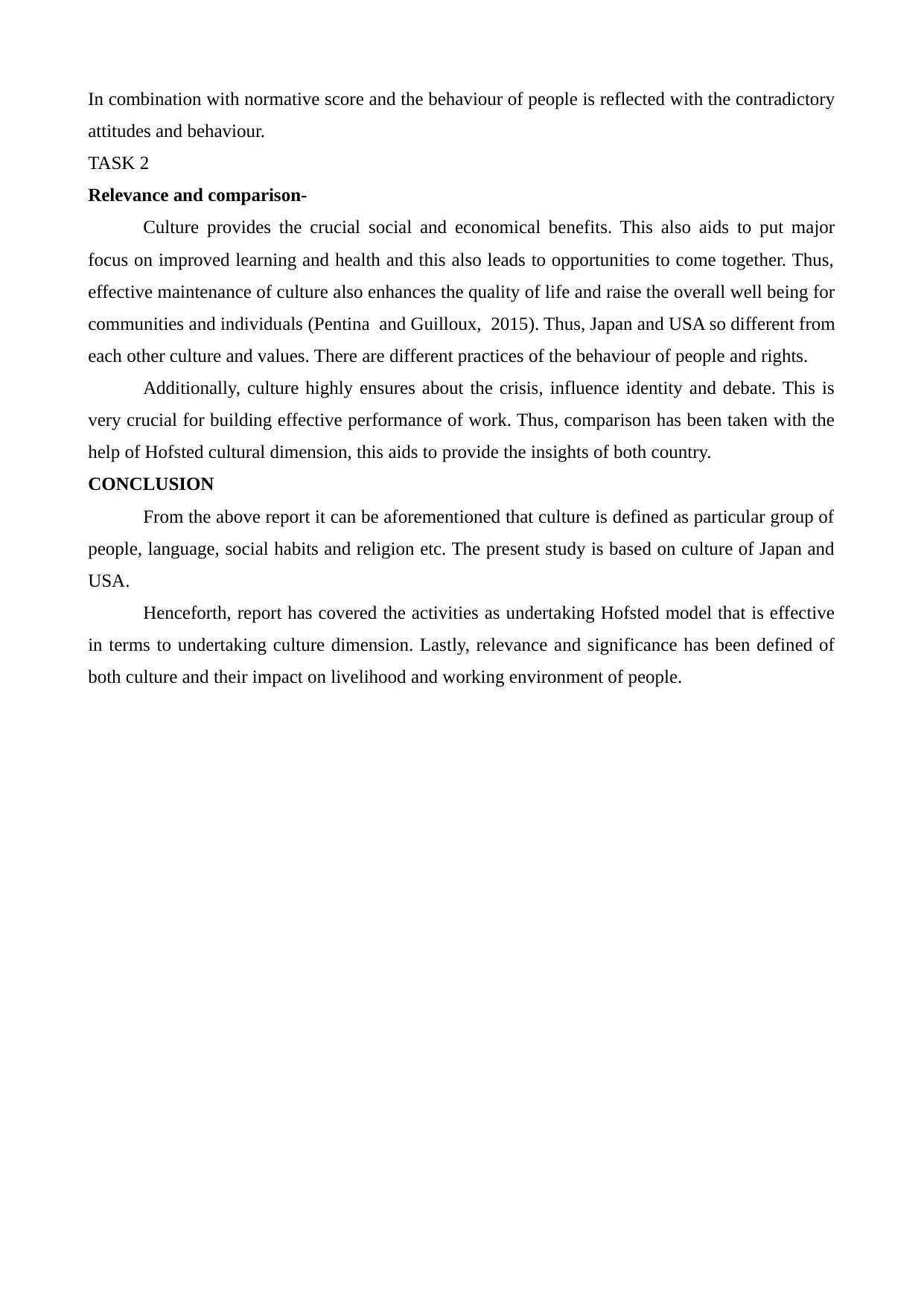Cross-Cultural Analysis: Comparing Cultural Dimensions of Japan & USA
VerifiedAdded on 2023/01/18
|7
|1991
|85
Report
AI Summary
This report undertakes a cross-cultural analysis, focusing on the cultural differences between Japan and the USA. It begins with an introduction to cross-cultural concepts and the importance of understanding these differences in a global business context. The report employs Hofstede's model, along with Hall and Hall's model, to compare cultural dimensions such as power distance, individualism, masculinity, uncertainty avoidance, and long-term orientation between the two countries. The analysis provides insights into how these cultural differences impact business practices, social interactions, and overall societal values. The report concludes by summarizing the key findings and emphasizing the relevance of cross-cultural understanding for effective communication and collaboration in a globalized world. The references include books and journals related to the subject.

CROSS CULTURE ANALYSIS
Paraphrase This Document
Need a fresh take? Get an instant paraphrase of this document with our AI Paraphraser

Table of Contents
INTRODUCTION................................................................................................................................3
CONCLUSION....................................................................................................................................6
REFERENCES.....................................................................................................................................7
INTRODUCTION................................................................................................................................3
CONCLUSION....................................................................................................................................6
REFERENCES.....................................................................................................................................7

INTRODUCTION
Cross culture defined as concept that identified the difference among business people of
different nations, ethnicities and background of bridging them. Each country has differed culture
from one another (Pentina and Guilloux, 2015). It assists enterprise to deal with individual coming
from differed culture background.
The present report will undertake the comparison between two countries as Japan and USA.
To build effective cross culture there is need to focus on two model as Hofsted, Halls and Halls and
Will. Additionally, evaluation will be undertaken on key perspective of three key traditional cross
culture analysis.
TASK 1
Hofsted model- It is defined as framework for cross cultural communication. This has impact over
society culture and on the value of members. This model aids to undertake the comparison with the
power distance, individualism, masculinity, uncertainty avoidance index and long term orientation
etc. This is model that aids to study the culture of two different nation as Japan and USA etc.
It is model that aids to represent the culture independent preference for one state over
another that distinguish from each other. Therefore, country scores on the dimension is relative.
Human and simultaneously all are unique. In other words that can be stated that culture can be used
meaningfully with the help of comparison. It is model that is context of following dimensions. It is
the model that identifies the dimension of culture that are globally applicable and including family
life. It is model that is very effective in order to undertake the distinguish between varied nation,
culture and culture dimensions and this has huge impact on business setting (Laroche, Kalamas
and Cézard, 2015).
Hall and hall model- It is defined as crucial theory that is consisted of four parts such as context,
time, space and information (Pentina and Guilloux, 2015). Therefore, this is theory that can be
sometimes very accurate when the another part is erroneous. In this, high context culture that
termed out as collectivist, have members that from stable, close relationship and give more value to
interpersonal relationship. This has defined high and low context cultural components and this
divided into following categories as are-
Context- High context culture termed out as there are many contextual components that
must taken into account and assist people to understand the rules. Low context culture ideas
are expected to be outspoken. High context culture termed out as make communicate in
ways that is implicit and rely highly on context (Diehl, Terlutter and Mueller, 2016). On
the other hand, low context culture is totality dependent over the explicit verbal
communication.
Time- According to this theory, there can be monochromes and polyphonous culture.
Cross culture defined as concept that identified the difference among business people of
different nations, ethnicities and background of bridging them. Each country has differed culture
from one another (Pentina and Guilloux, 2015). It assists enterprise to deal with individual coming
from differed culture background.
The present report will undertake the comparison between two countries as Japan and USA.
To build effective cross culture there is need to focus on two model as Hofsted, Halls and Halls and
Will. Additionally, evaluation will be undertaken on key perspective of three key traditional cross
culture analysis.
TASK 1
Hofsted model- It is defined as framework for cross cultural communication. This has impact over
society culture and on the value of members. This model aids to undertake the comparison with the
power distance, individualism, masculinity, uncertainty avoidance index and long term orientation
etc. This is model that aids to study the culture of two different nation as Japan and USA etc.
It is model that aids to represent the culture independent preference for one state over
another that distinguish from each other. Therefore, country scores on the dimension is relative.
Human and simultaneously all are unique. In other words that can be stated that culture can be used
meaningfully with the help of comparison. It is model that is context of following dimensions. It is
the model that identifies the dimension of culture that are globally applicable and including family
life. It is model that is very effective in order to undertake the distinguish between varied nation,
culture and culture dimensions and this has huge impact on business setting (Laroche, Kalamas
and Cézard, 2015).
Hall and hall model- It is defined as crucial theory that is consisted of four parts such as context,
time, space and information (Pentina and Guilloux, 2015). Therefore, this is theory that can be
sometimes very accurate when the another part is erroneous. In this, high context culture that
termed out as collectivist, have members that from stable, close relationship and give more value to
interpersonal relationship. This has defined high and low context cultural components and this
divided into following categories as are-
Context- High context culture termed out as there are many contextual components that
must taken into account and assist people to understand the rules. Low context culture ideas
are expected to be outspoken. High context culture termed out as make communicate in
ways that is implicit and rely highly on context (Diehl, Terlutter and Mueller, 2016). On
the other hand, low context culture is totality dependent over the explicit verbal
communication.
Time- According to this theory, there can be monochromes and polyphonous culture.
⊘ This is a preview!⊘
Do you want full access?
Subscribe today to unlock all pages.

Trusted by 1+ million students worldwide

Space- It has also defined the culture with help of attitude to personal space.
Information- It is forth dimension that defined by Hall. Culture with slow information, each
plan in entity frame carefully and structure it. Thus, culture with fast information spreads
more quickly.
Wills model- It is model that defines the high and low context of culture.
TASK 1
For undertaking the comparison between the china and USA, the selected the Hofsted model
of culture dimension. Therefore, this defined in following manner as are-
Power distance- It is termed out as extent that has less powerful members of institution and
organization within nation and this accepts that power is unequally distributed. In the power
distance, the Japan scores as 54. Thus, it is considered as borderline hierarchical society. Thus, most
of the tourist thinks that Japan is extremely hierarchical as there is slow decision-making process
and the all decision confirmed by the management of Top authority in Tokyo. Thus, USA power of
index rate is 40 (Moon, Lee and Oh, 2015). This means the USA has much effective power of
distribution rate than China. In the corporate world, the employees are self expected and be self
reliant and display initiative. Under this, promotion and decision are mainly based on evidence that
what they have done.
Individualism- This is defined as fundamental issue that needs to be addressed by this dimension
and this also termed out as degree of interdependence that means society maintains among
members. In this, Japan has scored 46 on the individual dimension. Thus, the society of Japanese
has shows the many characteristics of collective society. This means this nation put the unity of
group above the opinion of individual and that means people have strong sense of shame for losing
face (Durvasula, Lysonski and Watson, 2015). Japanese are experienced as collectivist with
Western standards and experienced as individualist with help of Asian standards. Thus, they are
more private and reserved than the most other Asians.
Masculinity- In this high score, the society will be driven with help of achievement, competition
and success. Japan is one of the most Masculine societies in the world and this scores at 95. This is
country that is considered as workaholism (Singh and Martinengo, 2015). There is strong notion in
the education system Japanese that everybody is born equal and anyone gets ahead and become
anything. It is not hierarchical as compare to the other Asian cultures. Therefore, the score of US
masculinity is 62 and can be seen as one of typical American pattern of behaviours.
Information- It is forth dimension that defined by Hall. Culture with slow information, each
plan in entity frame carefully and structure it. Thus, culture with fast information spreads
more quickly.
Wills model- It is model that defines the high and low context of culture.
TASK 1
For undertaking the comparison between the china and USA, the selected the Hofsted model
of culture dimension. Therefore, this defined in following manner as are-
Power distance- It is termed out as extent that has less powerful members of institution and
organization within nation and this accepts that power is unequally distributed. In the power
distance, the Japan scores as 54. Thus, it is considered as borderline hierarchical society. Thus, most
of the tourist thinks that Japan is extremely hierarchical as there is slow decision-making process
and the all decision confirmed by the management of Top authority in Tokyo. Thus, USA power of
index rate is 40 (Moon, Lee and Oh, 2015). This means the USA has much effective power of
distribution rate than China. In the corporate world, the employees are self expected and be self
reliant and display initiative. Under this, promotion and decision are mainly based on evidence that
what they have done.
Individualism- This is defined as fundamental issue that needs to be addressed by this dimension
and this also termed out as degree of interdependence that means society maintains among
members. In this, Japan has scored 46 on the individual dimension. Thus, the society of Japanese
has shows the many characteristics of collective society. This means this nation put the unity of
group above the opinion of individual and that means people have strong sense of shame for losing
face (Durvasula, Lysonski and Watson, 2015). Japanese are experienced as collectivist with
Western standards and experienced as individualist with help of Asian standards. Thus, they are
more private and reserved than the most other Asians.
Masculinity- In this high score, the society will be driven with help of achievement, competition
and success. Japan is one of the most Masculine societies in the world and this scores at 95. This is
country that is considered as workaholism (Singh and Martinengo, 2015). There is strong notion in
the education system Japanese that everybody is born equal and anyone gets ahead and become
anything. It is not hierarchical as compare to the other Asian cultures. Therefore, the score of US
masculinity is 62 and can be seen as one of typical American pattern of behaviours.
Paraphrase This Document
Need a fresh take? Get an instant paraphrase of this document with our AI Paraphraser

Individualism- It is fundamental issue that mainly addressed by the degree of interdependence that
maintains among the members. Therefore, Japan scores 46 in terms to individualism dimension.
Within the collectivist culture, individual are loyal to inner group by birth and this is extended by
family and local community (Pentina and Guilloux, 2015). Additionally, Japanese are mainly
experienced as collectivist with the Western standards and experienced individualist with the Asian
standards. This defined as that they are more and reserve than the other Asians.
Uncertainty Avoidance- It has to deal with the way that society deals with fact that future that can
be known. There are differed cultures that needs to learnt to deal this anxiety in different manner. In
this, Japan is considered at the score of 92 and that uncertainty avoiding countries on earth.
Additionally, manager needs to ask for all the detailed facts and figures before undertaking any
decision. Therefore, the high requirement for uncertainty avoidance is one of the reason in which
changes are difficult to realize in Japan. So, Japanese must be prepared about themselves for any of
the uncertain situation. This aids to deal with the varied level of the tough situation.
Thus, USA scores 46, this is country in which there is degree of acceptance for the
innovative ideas, commodities and willingness to try something new whether it relates with high
technical advancement.
Long term orientation- It is defined that has to maintain some links with own past at time of
dealing with the challenges of the present and future. Therefore, Japan scores at 88 in terms to Long
term orientation oriented societies. Therefore, the long term orientation is need to make high
constantly investment in R&D even in economically difficult times.
Indulgence- It is the dimension that termed out as extent in which individual take initiative to have
control on desires and impulse on the way that they were raised. This means that societies have high
restrained and that much put more focus on leisure time and also control the gratification of desires.
Illustration 1: Hofsted culture of Japan and USA
(Source: COUNTRY COMPARISON, 2019 )
maintains among the members. Therefore, Japan scores 46 in terms to individualism dimension.
Within the collectivist culture, individual are loyal to inner group by birth and this is extended by
family and local community (Pentina and Guilloux, 2015). Additionally, Japanese are mainly
experienced as collectivist with the Western standards and experienced individualist with the Asian
standards. This defined as that they are more and reserve than the other Asians.
Uncertainty Avoidance- It has to deal with the way that society deals with fact that future that can
be known. There are differed cultures that needs to learnt to deal this anxiety in different manner. In
this, Japan is considered at the score of 92 and that uncertainty avoiding countries on earth.
Additionally, manager needs to ask for all the detailed facts and figures before undertaking any
decision. Therefore, the high requirement for uncertainty avoidance is one of the reason in which
changes are difficult to realize in Japan. So, Japanese must be prepared about themselves for any of
the uncertain situation. This aids to deal with the varied level of the tough situation.
Thus, USA scores 46, this is country in which there is degree of acceptance for the
innovative ideas, commodities and willingness to try something new whether it relates with high
technical advancement.
Long term orientation- It is defined that has to maintain some links with own past at time of
dealing with the challenges of the present and future. Therefore, Japan scores at 88 in terms to Long
term orientation oriented societies. Therefore, the long term orientation is need to make high
constantly investment in R&D even in economically difficult times.
Indulgence- It is the dimension that termed out as extent in which individual take initiative to have
control on desires and impulse on the way that they were raised. This means that societies have high
restrained and that much put more focus on leisure time and also control the gratification of desires.
Illustration 1: Hofsted culture of Japan and USA
(Source: COUNTRY COMPARISON, 2019 )

In combination with normative score and the behaviour of people is reflected with the contradictory
attitudes and behaviour.
TASK 2
Relevance and comparison-
Culture provides the crucial social and economical benefits. This also aids to put major
focus on improved learning and health and this also leads to opportunities to come together. Thus,
effective maintenance of culture also enhances the quality of life and raise the overall well being for
communities and individuals (Pentina and Guilloux, 2015). Thus, Japan and USA so different from
each other culture and values. There are different practices of the behaviour of people and rights.
Additionally, culture highly ensures about the crisis, influence identity and debate. This is
very crucial for building effective performance of work. Thus, comparison has been taken with the
help of Hofsted cultural dimension, this aids to provide the insights of both country.
CONCLUSION
From the above report it can be aforementioned that culture is defined as particular group of
people, language, social habits and religion etc. The present study is based on culture of Japan and
USA.
Henceforth, report has covered the activities as undertaking Hofsted model that is effective
in terms to undertaking culture dimension. Lastly, relevance and significance has been defined of
both culture and their impact on livelihood and working environment of people.
attitudes and behaviour.
TASK 2
Relevance and comparison-
Culture provides the crucial social and economical benefits. This also aids to put major
focus on improved learning and health and this also leads to opportunities to come together. Thus,
effective maintenance of culture also enhances the quality of life and raise the overall well being for
communities and individuals (Pentina and Guilloux, 2015). Thus, Japan and USA so different from
each other culture and values. There are different practices of the behaviour of people and rights.
Additionally, culture highly ensures about the crisis, influence identity and debate. This is
very crucial for building effective performance of work. Thus, comparison has been taken with the
help of Hofsted cultural dimension, this aids to provide the insights of both country.
CONCLUSION
From the above report it can be aforementioned that culture is defined as particular group of
people, language, social habits and religion etc. The present study is based on culture of Japan and
USA.
Henceforth, report has covered the activities as undertaking Hofsted model that is effective
in terms to undertaking culture dimension. Lastly, relevance and significance has been defined of
both culture and their impact on livelihood and working environment of people.
⊘ This is a preview!⊘
Do you want full access?
Subscribe today to unlock all pages.

Trusted by 1+ million students worldwide

REFERENCES
Books and journals
Diehl, S., Terlutter, R. and Mueller, B., 2016. Doing good matters to consumers: the effectiveness
of humane-oriented CSR appeals in cross-cultural standardized advertising
campaigns. International Journal of Advertising, 35(4), pp.730-757.
Durvasula, S., Lysonski, S. and Watson, J., 2015. A Cross-Cultural Examination of a Scale to
Measure Trait Aspects of Vanity. In Proceedings of the 1997 World Marketing Congress (pp.
55-57). Springer, Cham.
Laroche, M., Kalamas, M. and Cézard, A., 2015. The Impact of Information Sources on Service
Quality Expectations: a Cross-Cultural Comparison. In Proceedings of the 2002 Academy of
Marketing Science (AMS) Annual Conference (pp. 160-160). Springer, Cham.
Mintz, O. and et.al., 2019. Managerial metric use in marketing decisions across 16 countries: A
cultural perspective. Journal of International Business Studies, pp.1-27.
Moon, B.J., Lee, L.W. and Oh, C.H., 2015. The impact of CSR on consumer-corporate connection
and brand loyalty: A cross cultural investigation. International Marketing Review, 32(5),
pp.518-539.
Pentina, I. and Guilloux, V., 2015. Developing a Grassroots Cross-Cultural Partnership to
Enhance Student Experiences. In Marketing and Consumer Behavior: Concepts,
Methodologies, Tools, and Applications (pp. 1105-1117). IGI Global.
Singh, N. and Martinengo, R., 2015. Studying cultural values on the web: a cross-cultural study of
US and Mexican Web Sites. In Proceedings of the 2002 Academy of Marketing Science
(AMS) Annual Conference (pp. 146-146). Springer, Cham.
Zhi, Z.E.N.G., 2017. Research on Cross-Cultural Marketing of Traditional Chinese Medicine at
the Belt and Road Initiative—Take Acupuncture as an Example. DEStech Transactions on
Social Science, Education and Human Science, (icss).
Online
COUNTRY COMPARISON. 2019[Online]Available
through:<https://www.hofstede-insights.com/country-comparison/japan/>.
Books and journals
Diehl, S., Terlutter, R. and Mueller, B., 2016. Doing good matters to consumers: the effectiveness
of humane-oriented CSR appeals in cross-cultural standardized advertising
campaigns. International Journal of Advertising, 35(4), pp.730-757.
Durvasula, S., Lysonski, S. and Watson, J., 2015. A Cross-Cultural Examination of a Scale to
Measure Trait Aspects of Vanity. In Proceedings of the 1997 World Marketing Congress (pp.
55-57). Springer, Cham.
Laroche, M., Kalamas, M. and Cézard, A., 2015. The Impact of Information Sources on Service
Quality Expectations: a Cross-Cultural Comparison. In Proceedings of the 2002 Academy of
Marketing Science (AMS) Annual Conference (pp. 160-160). Springer, Cham.
Mintz, O. and et.al., 2019. Managerial metric use in marketing decisions across 16 countries: A
cultural perspective. Journal of International Business Studies, pp.1-27.
Moon, B.J., Lee, L.W. and Oh, C.H., 2015. The impact of CSR on consumer-corporate connection
and brand loyalty: A cross cultural investigation. International Marketing Review, 32(5),
pp.518-539.
Pentina, I. and Guilloux, V., 2015. Developing a Grassroots Cross-Cultural Partnership to
Enhance Student Experiences. In Marketing and Consumer Behavior: Concepts,
Methodologies, Tools, and Applications (pp. 1105-1117). IGI Global.
Singh, N. and Martinengo, R., 2015. Studying cultural values on the web: a cross-cultural study of
US and Mexican Web Sites. In Proceedings of the 2002 Academy of Marketing Science
(AMS) Annual Conference (pp. 146-146). Springer, Cham.
Zhi, Z.E.N.G., 2017. Research on Cross-Cultural Marketing of Traditional Chinese Medicine at
the Belt and Road Initiative—Take Acupuncture as an Example. DEStech Transactions on
Social Science, Education and Human Science, (icss).
Online
COUNTRY COMPARISON. 2019[Online]Available
through:<https://www.hofstede-insights.com/country-comparison/japan/>.
1 out of 7
Related Documents
Your All-in-One AI-Powered Toolkit for Academic Success.
+13062052269
info@desklib.com
Available 24*7 on WhatsApp / Email
![[object Object]](/_next/static/media/star-bottom.7253800d.svg)
Unlock your academic potential
Copyright © 2020–2025 A2Z Services. All Rights Reserved. Developed and managed by ZUCOL.




